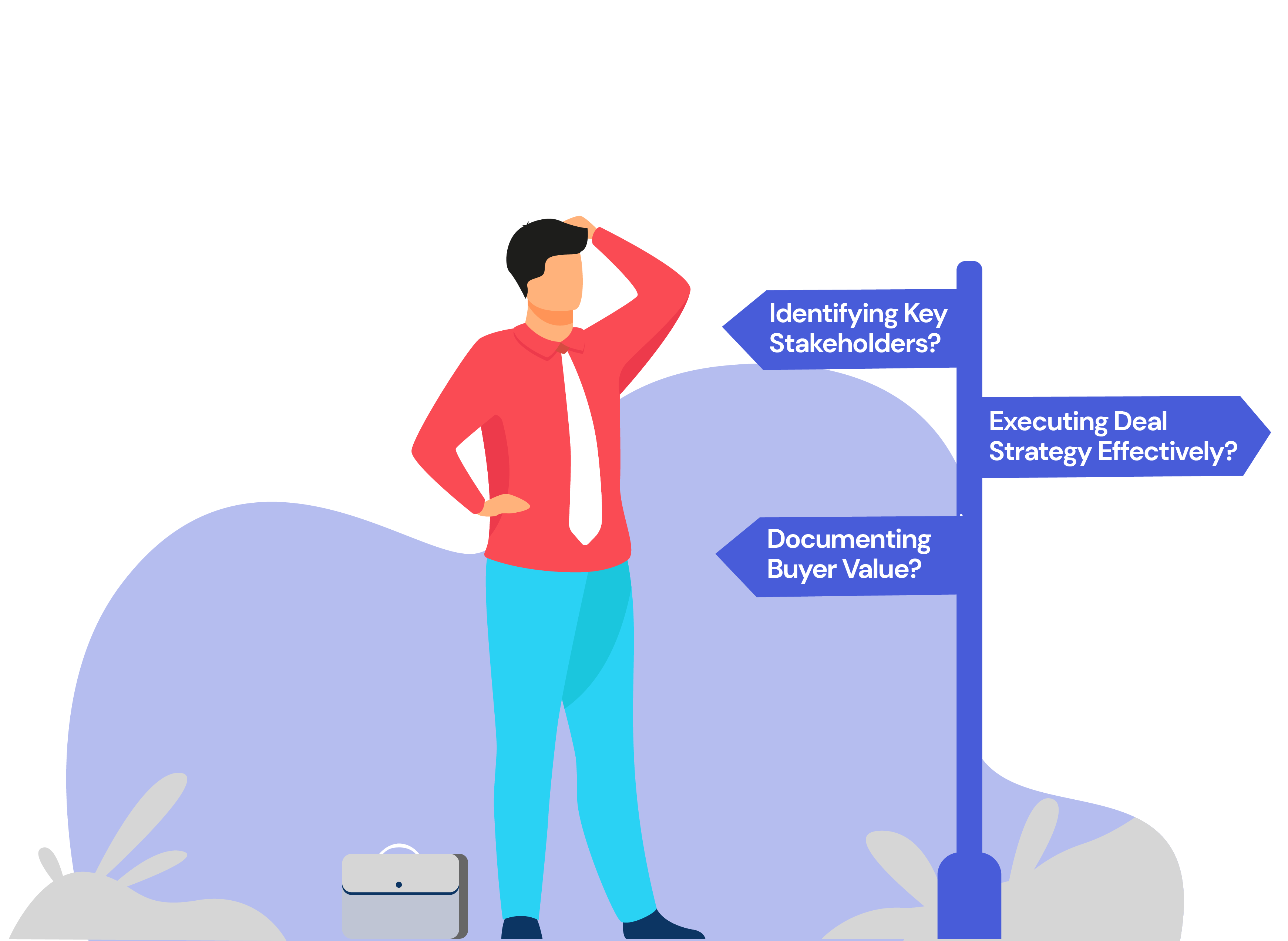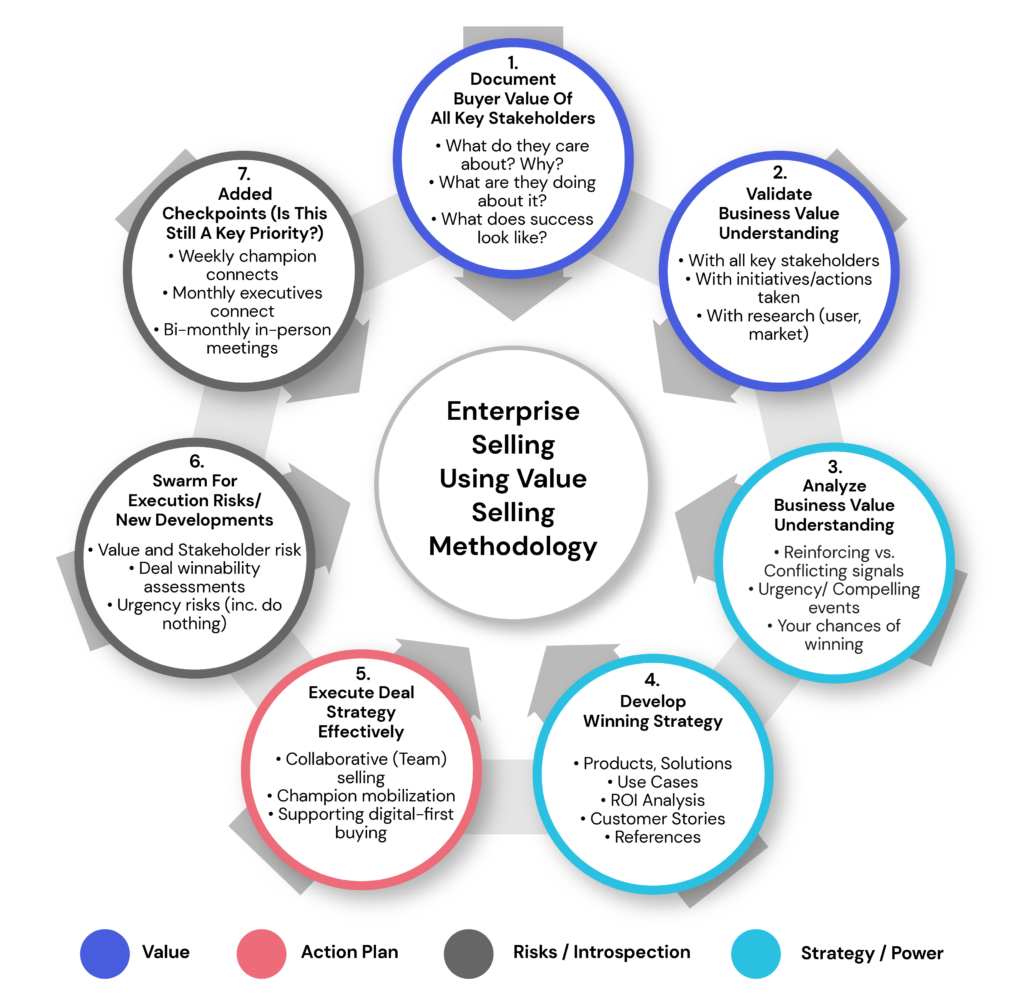 BACK TO BLOG
BACK TO BLOG
Are You Doing Value Selling Right?

 BACK TO BLOG
BACK TO BLOG

We're in the middle of a recession, or at least in anticipation of one. This means most businesses have slashed budgets, delayed purchases, and brought in their CFOs for hands-on spending regulation. Enterprise selling has been challenging since dawn, and this challenge is only growing in the current environment.
What are some strategies which can help you continue to perform in the current market?
The use of sales methodologies can be the answer if the following conditions are true:
(i) you are selling $250K+ ARR deals to enterprise companies. These deals can take 4-10 months and can involve 5-15 decision-makers
(ii) Your buyers (or champions) have to go the extra mile to get the funding and approval, more so in the current market
(iii)You are in a highly competitive market, and it is not possible to differentiate on product or features. The one that can sell on the basis of business results will ultimately have more deals than others.
Good sellers learn best practices from all sales methodologies they are exposed to come up with their own framework to engage buyers and win deals. Personally, Value selling methodology has had the greatest impact on my own journey as a salesperson.
At the core, Value Selling is about understanding the business value and motivations of all decision-makers and influencers and using this information to show them how you are the best partner to deliver that value for them (assuming their expectations align with your expertise).
Value selling done right can change how your customers view a potential purchase from you. This approach not only helps you better pitch to clients but also enables you to choose your target market more effectively.
Value selling can help counter two of the biggest challenges faced by deals today: Firstly, the number of decision-makers has increased. Secondly, you cannot win a deal by catering to the decision-makers needs. The influencers are a lot more critical for a ‘yes’ since they are ultimately responsible for driving the usage of the solution.
There are three breakpoints in an ineffective Value Selling implementation. These can occur in isolation or in combination with each other. Your reps may also be distributed across these scenarios.
This ties back to the ability to understand the concepts taught in training; hence, this breakpoint should ideally be less common than the others. Some of the best companies and sales leaders have their sellers describe the benefits of Value Selling to their prospects so they can buy in and collaborate on the same framework. The conversation goes something like this, “Jane, we use the Value Selling framework on our side so that we can deliver the best business value for you and your team. Let me tell you how it works.”
How to spot it? One easy way to identify if this is an area of improvement for your team: is to validate their audible readiness for this conversation using your enablement process (like pitch certification, reviewing and certifying discovery call recordings). It should be easy to spot who has their concepts right and who has not.
This is trickier than the previous one because it has to factor in the nuances of each deal and the stakeholders involved. Therefore, it is also where most Value Selling implementations break. To spot if this is an area of concern, identify if your team looks at the Value Selling tool (excel or digital) as a data entry compliance exercise or a strategic tool.
How to spot it? There are two ways to verify this - 1) Are they able to articulate their deal strategy using the different components of the Value Selling framework (like value matrix, decision power, disposition, closing plan, etc.)?, or 2) If you suspended the methodology program tomorrow, would your team be relieved or disappointed (ignore any resistance that comes just because they’ve entered some information into the system)?
Since Value Selling methodology is how you want your sellers to think and operate on a day-to-day basis, it is essential to ensure that all associated non-selling workflows, like deal reviews, swarm meetings, forecasting, etc., are also tied back to this. Otherwise, it causes friction in the experience for your team, but more importantly, it disincentives them to adopt the methodology.
How to spot it? Two associated risks lead up to this breakpoint.
To begin with, is the data going into your Value Selling tool (Excel, CRM, or something else?) aligned with actual buyer perspectives? This is easy to spot if you have a Conversational Intelligence (CI) tool. Have your managers inspect some of the information points & confirm the seller's understanding. However, if you do not have a CI tool, you could have your managers sit on a few of these calls and/or do an independent discussion with the primary buyer to confirm your team’s understanding.
Secondly, assuming the quality of data is not a concern, does your leadership team have a single-pane view of the deal strategy & associated risks in a way that facilitates collaboration & decision-making? As a sales leader, you can spot this by introspecting how much of your deal discussions - context, progress, risks, updates, etc. happen using the Value Selling framework: Are deal reviews objective (as prescribed in value selling) or subjective? Is your understanding of deals excessively influenced by your perception of the seller or manager working the deal? In our interviews, we’ve seen that even seasoned sales leaders fall into this trap despite being fully aware of it. It’s one of those human psychology things that work through constant, periodic reinforcements.

One of the most significant risks in effectively implementing Value Selling is connecting the expectations and concepts with the actual workflows involved in enterprise selling. We have developed a framework that tightly connects key components of Value Selling frameworks with the actual workflows involved in managing an enterprise deal.
Your sellers are dealing with several buyers distributed across different teams in an organization (Core business team, IT, finance, legal, and more), and each of them very specific influence on the deal. And so, one of the most critical tasks for sellers is to identify these buying stakeholders and their roles and create a standout value prop for their pain mapping the collective need. Without analyzing a visual representation of the relationships with the opportunity, you can’t strategize the people strategy in a deal.
Bestsellers build trust by sharing their sales strategy with their buyers - “Jane, we use the Value Selling framework on our side to deliver the best business value for you and your team. Let me tell you how it works.” Once you’ve set the momentum, sellers and buyers can regularly align on achieving the potential value. There are two big stages in any sales process - becoming the vendor of choice and signing the contract. So many things need to fall in place to win a deal. One wrong step, and whoop! Your deal slips into the next quarter. Once the opportunity becomes real, the seller should uncover:
If you have read till here, you will agree that, Value > Solution. How well your sellers identify real challenges and show how your solution can uniquely solve that problem is what will help them win deals predictably. How would your salespeople do that consistently? Aligning on value statement, their milestones, deadlines, and working backward on your sales-specific timelines. Ensure that your rep captures the objective success measures, initiatives, etc., into a value summary and aligns with each decision maker and economic buyer to drive urgency.
Now that you’ve validated and analyzed business value, it is time to reinforce your position as their go-to- solution by connecting the dots between the problem, your solution, and use cases. A deep ROI analysis with how you created value for your customers backed with success stories and references of current clientele would help you position yourself better in the long haul.
In any enterprise sales cycle, high-impact activities like workshops, custom demos, POVs, and more incur a significant impact on your ongoing deals. Work with your champion to capture key tasks that are needed to be completed in order to win the deal with clear accountability around ownership and due dates. Obtain inputs from other decision-makers to confirm their agreement on a mutual action plan. Lastly, monitor the progress to confirm deal velocity on a weekly basis.
We often look at different qualification frameworks to identify risks in a deal. But does that give you the full picture, especially in big deals? Evaluate risks by understanding specific, pointed questions that each rep and their answer to assess risk areas. Keep a quantitative score for each of these questions to ensure you know the motion of your undertaking. For new developments, capture qualitative information and key actions to review and follow up in the next deal review assessment.
Once you identify the opportunity and as the spearheader motion of the process, updating your relationship map is non-negotiable. The best practice is to update the plan on a monthly or quarterly cadence to ensure it holds credibility and helps your team strategize their next steps better. Weekly champion connects, monthly executives connect, and bi-monthly in-person meetings are one way to go about it.

Selling is hard work, and when it comes to enterprise selling, it’s even more difficult. Unless you truly understand what your buyers value, how they gather information, and how purchase decisions get made, sales efforts will fall short. A predictable B2B buyer experience starts with the sales team clearly understanding the value creation opportunity, your implementation team setting the right foundation for value realization, and your customer success teams continuing to reinforce value delivered and finding new value-creating opportunities for the customer that the customer can realize using your product or service.
BuyerAssist Sales Execution Platform empowers enterprise sellers with tools for planning, executing, and collaborating around large deals to win buyer trust and accelerate growth. Additionally, the platform helps sales leaders know which deals are on track and supports others to get on track. We simplify value-selling execution by
Relationship Maps help the deal team visualize all the buying stakeholders, their roles, influence, and path to a decision. It serves three purposes:
Top-performing sellers build and manage “Mutual Action Plans” with the most influential and supportive buyers (ideally the Catalysts). These documents clarify all of the tasks, task owners, and task due dates required for the buyer to make the purchase and realize their success measures on schedule.
The DRA enables sellers and their managers to review risk in each deal on key criteria that are most critical to closing the deal or knowing when to walk away. For example, does the seller adequately understand the objectives/success measures of key buyers? Does each decision-maker agree with it? Has the seller surfaced the costs of inaction with key buyers, and are they compelling? Does the seller fully understand the buyer’s purchase process, and are they fully aligned with the Champion on what will happen next and when?”
To execute the DRA, sellers choose a numeric score from a drop-down menu that reflects the extent to which they’ve addressed each criterion. This produces a quantitative “Deal Risk Score” and a qualitative recommendation for how best to proceed, given the quantitative score. The individual scores for each criterion are tailored but follow the same general framework.
As competition continues to increase, finding points of differentiation is crucial to building a customer base that trusts what you offer. For deals over $100 ARR, it is important that you understand the value the buyer desires, the buying process, and complexities around buyer dynamics and deal risk management. Need of the hour requires you to use tools like relationship maps for every deal to ensure buyers are confident in their purchase decisions and that sales management has credible data to forecast accurately.
